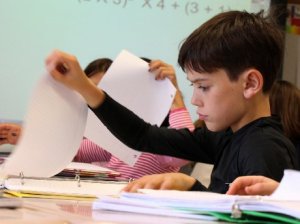4 Ways to Have Your Best Year Ever in Math

At the end of last year, I met with a group of K-5 teachers to talk about a math training they had just completed. As we wrapped up a discussion about new strategies they had learned and put to work in their classrooms, I asked if they had any regrets. The most common answer was, “I just wish I had known all of this on the first day of school!”
With that in mind, I want to share four “big ideas” that came out of the training. Enjoy!
A Little Confusion Goes a Long Way
The concept of “productive struggle” has gained a lot of momentum in education in recent years. The basic idea is that students learn most when they are engaged, and one of the best ways to engage them is to present them with a problem that they might be able to solve, then let them struggle with it for a few unscaffolded minutes. Sounds scary? It is! But relinquishing control for a few minutes each day and letting the students wrestle with a challenge offers a huge payoff in the end: (1) your students learn what it feels like to sweat, to stick it out, and to overcome a challenge; (2) when it comes time to solve, they are more invested in the solution; (3) the strategies they come up with activate prior knowledge and set the foundation for new learning — and tip you off about how they think and what they know and don’t know.
Try this: Select a story problem your students might be able to solve. With only minimal instructions to get them started, set a timer for 5-10 minutes while they grapple with the problem. See where the productive struggle leads! (Note: Teachers have warned that it can take 5-6 attempts to find the right challenge level and get the timing down — but it’s worth it when you hit your stride!)
“So you’re saying… Is that right?”
“Academic conversation” has become a popular buzzword in education circles. It’s well-documented (and self-evident in any elementary classroom) that students learn a lot by hearing their classmates’ ideas and discussing amongst themselves. But a student can also learn a lot just from hearing his or her own words restated. You don’t have to bring a handheld recording device to every discussion — it’s enough to parrot their words right back to them and ask what they think!
Try this: When a child answers a “how” or “why” question, repeat the answer back to them without editing or cleaning it up. “So you’re saying… Is that right?” You’ll know you’re doing it well when a student politely disagrees… with herself!
Conjecture Boards
Math is all about identifying patterns. It’s critical for students recognize patterns, see connections, and make generalizations about their learning. Conjectures are simple, unproven observations about shapes and numbers (eg: “all triangles have three sides” or “the product of a whole number and a proper fraction is less than the whole number”). They can be put to excellent use in the elementary math classroom.
Try this: Every time a student makes a conjecture, CELEBRATE! Restate the conjecture, write it down, name it after the student (“Donovan’s Conjecture”), and post it in a visible location, so you can return to it in the future. You will be amazed how often students refer back to their classmates’ ideas — and how quickly they internalize the importance of seeing the big picture!
Give Students Hand Signals to Show Their Thinking
Many teachers use hand signals (some adapted directly from American Sign Language) to help students express themselves without interrupting the flow of a class. You may already use signals for going to the bathroom or agreeing with another student. Hand signals can also be used in academic discussions. Without a word, students can show that they want to paraphrase or build on an idea, make a conjecture, share a “point of interest” (confusion about another student’s idea), and even encourage classmates to “keep going” when they’re explaining their thinking. Not only do the signals provide new entry points into conversation for all students (including those who are shy or not proficient in English), but it gives the teacher insight into what their students are thinking throughout a discussion.
Try this: Introduce academic hand signals one at a time. Encourage students to incorporate them into math discourse. Hand signals will quickly become a part of daily classroom practice!